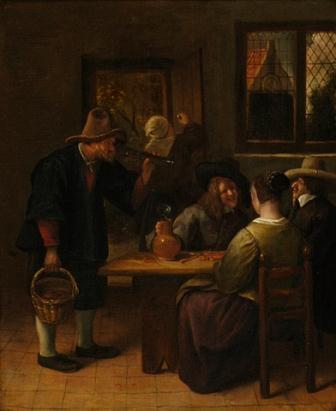The following explanation is provided:As regards NK 1683, in its research results the BHG regarded ‘Katz’ as provenance as ‘very uncertain’. Further research conducted by the Committee has shown that on the ‘White Card’, an SNK inventory card, the name Katz is crossed out and replaced with the name of another art dealership, a name borne out in other documents found. The Committee is therefore of the opinion that ‘Katz’ as provenance on the White Card is a mistake.With reference to NK 1929, the BHG regarded ‘Katz’ as provenance as ‘uncertain’. After additional research, the Committee concluded that the available provenance details are so fragmented and contradictory that ownership by Katz is not plausible.As far as NK 1532, NK 1537, NK 1547, NK 1551, NK 1757, NK 2384, NK 2614 and NK 2732 are concerned, indications were found in the sources consulted from which it could be concluded that Katz art dealers did, at an unknown time, have something to do with these works, such as an entry ‘Katz’ on a photo card found in the Netherlands Institute for Art History or in an SNK inventory book. Clear indications are lacking, however. The Committee regards these indications as insufficient to bear out the conclusion that ownership by Katz during the occupation is plausible.
As regards the works with inventory numbers NK 1515, NK 1521, NK 1564, NK 1604, NK 1842, NK 2084, NK 2186, NK 2245, NK 2366, NK 2496, NK 2497, NK 2586, NK 2597, NK 2693 and NK 2463, indications have been found that they were in Katz art dealers’ possession during the 1930s. However, no indications were found that would suggest that they were in Katz’s possession during the occupation. Moreover, possession of the vast majority of these works passed from a party other than Katz to a German buyer during the occupation. With regard to one of the works in this group, NK 2463, the results of the investigation show that the painting was on the premises of Katz art dealers in 1934 and/or 1935 but that it was part of the collection of Jewish entrepreneur Hans Ludwig Larsen in 1937 and was purchased from the latter’s estate for Adolf Hitler’s Sonderauftrag Linz. This rules out Katz as owner of NK 2463 during the occupation.
As regards NK 1658 and NK 2487, these works were, at any rate from the mid-1930s on, the property of J.G. Fockema-Vié and her husband H.W.J. Fockema of Brussels and, until August 1939 and June 1941, respectively, on loan to the Gemeente Museum Arnhem. Both paintings were sold to Adolf Hitler’s Sonderauftrag Linz in 1941 by or through Katz art dealers. Concerning NK 1658, BHG stated that: ‘Het is waarschijnlijk dat kunsthandel Katz het schilderij in juli 1941 voor mevrouw Fockema – Vié heeft verkocht. Katz heeft meerdere schilderijen uit het bezit van de familie Fockema (o.a. NK 2487), in bruikleen bij het Gemeentemuseum Arnhem, verkocht in Duitsland.’ [It is likely that Katz art dealers sold the painting in July 1941 on behalf of Mrs Fockema – Vié. Several art works belonging to the Fockema family (among others NK 2487) and on loan to the municipal museum in Arnhem were sold by Katz in Germany.]
On the basis of the fact-finding investigation, the Committee, too, is of the opinion that Katz art dealers did not act as owner but as intermediary in this sale.
Similarly, the Committee believes that Katz acted as intermediary in the case of NK 1663. The painting was at Katz art dealers in 1939 and was then purchased by W.A. Hofer, Hermann Göring’s representative, during the occupation. It can be concluded from documents prepared by the Allies after the war that at the time of the sale, the work was part of the collection of H.E. ten Cate, an art collector from Almelo, who sold the work through Katz. BHG states in the provenance details that ‘Katz was als tussenpersoon betrokken bij de verkoop tussen Ten Cate en Hofer’[Katz acted as intermediary between Ten Cate and Hofer for the sale of the painting], a conclusion shared by the Committee.
The investigation of NK 1766 also points to Katz as intermediary rather than owner. From reports drawn up by the Allies after the war, which are currently in the Bundesarchiv Koblenz, it can be concluded that the painting was sold to the Sonderauftrag Linz by J. de Wit on 9 November 1942. Moreover, information on the SNK’s ‘White Card’ indicates that the painting originated from ‘Katz, Dieren’ in 1942. As regards its provenance, the BHG concluded on the basis of this that: ‘Het is mogelijk dat kunsthandel Katz bemiddeld heeft bij een verkoop door J. de Wit’ [It is possible that art dealer Katz mediated in a sale by J. de Wit]. On the strength of this information, the Committee deems it plausible that Katz’s relationship to NK 1766 was one of intermediary rather than owner.
As far as NK 2209 is concerned, a single entry on a photo card found in the Netherlands Institute for Art History points to the work having been at Katz art dealers at some point in 1940. Finally, it is also known of NK 2594 that Esher Surrey art dealers of The Hague purchased it from Katz art dealers at an unknown date and then sold it to Adolf Hitler’s Sonderauftrag Linz in September 1940. However, no exact date is known for either work nor whether Katz was the owner or acted as intermediary. The Committee therefore deems it insufficiently proven that Katz owned them at the time of the German invasion on 10 May 1940. The Committee also takes into consideration that, as shown above, Katz frequently mediated in sales transactions and that a mention of the name Katz in provenance details – or the presence of a work on the art dealers’ premises – does not automatically mean that Katz should be regarded as the owner of that work.
